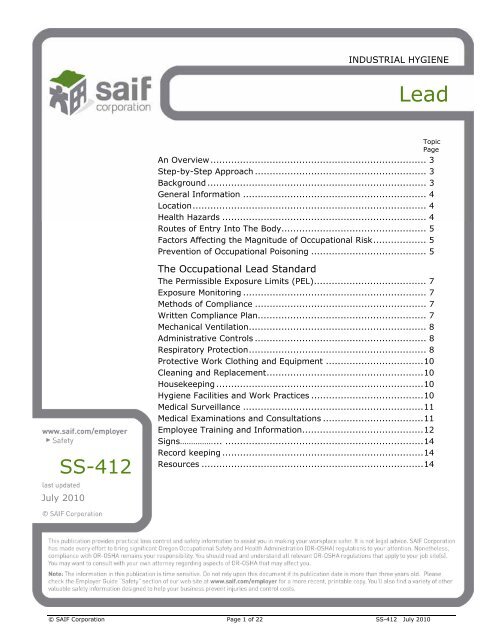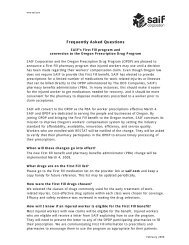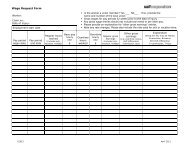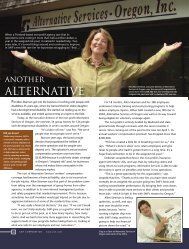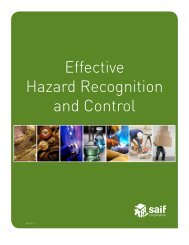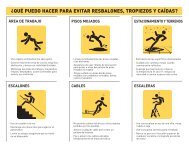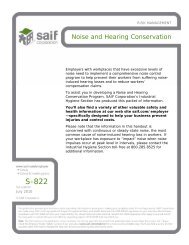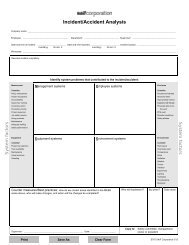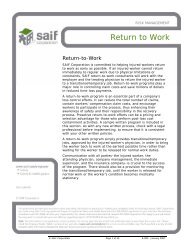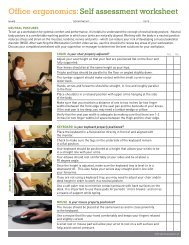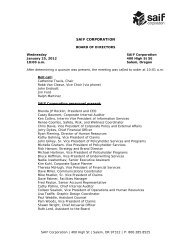Lead - SAIF Corporation
Lead - SAIF Corporation
Lead - SAIF Corporation
Create successful ePaper yourself
Turn your PDF publications into a flip-book with our unique Google optimized e-Paper software.
INDUSTRIAL HYGIENE<strong>Lead</strong>TopicPageAn Overview ......................................................................... 3Step-by-Step Approach .......................................................... 3Background .......................................................................... 3General Information .............................................................. 4Location ............................................................................... 4Health Hazards ..................................................................... 4Routes of Entry Into The Body ................................................. 5Factors Affecting the Magnitude of Occupational Risk .................. 5Prevention of Occupational Poisoning ....................................... 5SS-412The Occupational <strong>Lead</strong> StandardThe Permissible Exposure Limits (PEL) ...................................... 7Exposure Monitoring .............................................................. 7Methods of Compliance .......................................................... 7Written Compliance Plan ......................................................... 7Mechanical Ventilation ............................................................ 8Administrative Controls .......................................................... 8Respiratory Protection ............................................................ 8Protective Work Clothing and Equipment ................................. 10Cleaning and Replacement ..................................................... 10Housekeeping ...................................................................... 10Hygiene Facilities and Work Practices ...................................... 10Medical Surveillance ............................................................. 11Medical Examinations and Consultations .................................. 11Employee Training and Information ......................................... 12Signs…………… ... ................................................................... 14Record keeping .................................................................... 14Resources ........................................................................... 14July 2010© <strong>SAIF</strong> <strong>Corporation</strong> Page 1 of 22 SS-412 July 2010
Industrial Hygiene <strong>Lead</strong>-General Industrywww.saif.comReproductive effects: Among male workers, symptoms of overexposure include;impotence, decreased ability to produce healthy sperm and sterility. Among femaleworkers, symptoms of overexposure include; abnormal ovarian cycles, menstrualdisorders, premature childbirth, sterility, spontaneous miscarriage and stillbirth.Infants of mothers with lead poisoning have lower birth weights, slower growth andnervous system disorders.Routes of Entry<strong>Lead</strong> may be absorbed through the lung via airborne dust or fume, or ingested viafood, contaminated drinks, cosmetics and cigarettes contaminated with lead.Employee’s families may be exposed to lead from contaminated clothing andarticles brought home from the place of employment or from painted surfaces.Children six years old and younger are more at risk than adults.Factors Affecting the Magnitude of Occupational RiskThe process: The process in itself is important. High processing temperatures,extensive fume, dust or aerosol formation and outdated working methods increasethe risk—the more extreme the conditions, the greater the risk.Engineering controls: The adequacy of the elimination technique used directlyimpacts the occupational lead exposure. Efficient ventilation, combined withprevention techniques to reduce or eliminate the spreading of lead dust, greatlyreduce the risk.The two methods of ventilation used are dilution ventilation and local exhaustventilation. Dilution ventilation (general ventilation) is the dilution of contaminatedair with uncontaminated air for the purpose of controlling potential airborne healthhazards, fire and explosive conditions, odors and nuisance type contaminants. Dueto lead’s toxicity, dilution ventilation alone is usually not recommended as a controlmeasure for lead exposures.Local exhaust ventilation (LEV) is the most desirable method for removal of leadfume and dust in the work place. Effective local exhaust systems capture andremove the contaminant prior to it entering the employee’s breathing zone and thegeneral work environment.Workplace hygiene: Housekeeping, personal hygiene and personal protectiveequipment (PPE) have an impact on the magnitude of workplace exposure.Prevention of Occupational PoisoningSubstitution by less toxic substances: The ideal method of prevention is thesubstitution for a toxic agent with one less toxic in nature. This can be achallenging decision. Some material substitutes have little information available asto the toxic effects, so research into the substitute material should be extensive.Ventilation: An effective (LEV) system is one of the best methods for thecontrol of atmospheric contamination. The air must not be re-circulated ordiscarded in a way that would cause environmental pollution. It is important toremember that open windows and doors or cooling fans can interfere with theeffectiveness of the ventilation system. Regular cleaning and maintenance of theventilation system is critical.© <strong>SAIF</strong> <strong>Corporation</strong> Page 5 of 22 SS-412 July 2010
Industrial Hygiene <strong>Lead</strong>-General Industrywww.saif.comHousekeeping: The prevention of spreading of dust and fume is critical tominimize exposure. Vacuuming is the preferred method, by use of a HEPA (highefficiency particulate air filter). Proper use of a HEPA vacuum prevents the dustfrom being dispersed back into the air. It is important that when the HEPA vacuumsare cleaned and the filter disposed, that dust be controlled in order to minimize thereentry of lead into the workplace. Use of compressed air to clean floors and othersurfaces is absolutely prohibited.Eating, drinking, smoking and applying lip balm and cosmetics must be prohibitedin areas where lead is used.Hygiene facilities such as lunch room change room and showers may be needed foremployees exposed to lead.Protective coveralls or clothing must be laundered by the employer.Contaminated clothing must be properly bagged and labeled before being sent toa laundry facility.Personal protective equipment (PPE): Use personal protective equipment whenengineering control measures fail to reduce exposures to an acceptable level. Thetype of respiratory protection recommended varies according to the airborneconcentration of lead.© <strong>SAIF</strong> <strong>Corporation</strong> Page 6 of 22 SS-412 July 2010
Industrial Hygiene <strong>Lead</strong>-General Industrywww.saif.comThe Occupational <strong>Lead</strong> Standard• The Oregon Administrative Rule, Chapter 437, Division 2, GeneralOccupational Safety and Health Rules (29 CFR 1910) Subdivision Z:Toxic & Hazardous Substances: LEAD (1910.1025) applies to alloccupational exposures to lead excluding construction and agriculture.Highlights of the General Industry <strong>Lead</strong> Standard:The Permissible Exposure Limits (PEL)• Time Weighted Average Permissible Exposure Limit (TWA-PEL) is 50micrograms of lead per cubic meter of air (µg/M 3 ) averaged over aneight hour period.• Action Level Exposure is 30µg/M 3 averaged over an eight hour period.Exposure MonitoringIt is each employer’s responsibility under the statute to determine employeeexposures to lead at or above the action level. The standard bases these provisionsonly on exposure levels, and applies whether or not the employees wearrespiratory protection. Employees must be told of the exposure monitoring resultswithin 15 working days of receipt.Methods of Compliance (When employee exposure exceeds the PEL)Engineering and work practice controls: If an employee is exposed to leadabove the PEL for more than a total of 30 days per year, the employer mustimplement engineering and work practice controls (including administrativecontrols) to reduce and maintain employee exposures to lead below the PEL.Wherever the engineering and work practice controls, which can be implemented,are not sufficient to reduce employee exposure to or below the PEL, the employershall nonetheless use them to reduce exposures to the lowest feasible level andshall supplement them by the use of respiratory protection. Where any employeeis exposed to lead above 200 µg/m 3 , but for 30 days or less per year, the employershall implement engineering controls to reduce exposures at or below 200 μg/m 3 .If the employee exposure is below 200 µg/m 3 but above 50 µg/m 3 any combinationof engineering, work practice (including administrative controls), and respiratorycontrols may be implemented to reduce and maintain employee lead exposure to orbelow 50 µg/m 3 .Written Compliance PlanA written compliance plan is needed if the employer must reduce exposures to orbelow the PEL by means of engineering and work practice controls.The plan must be readily accessible at the workplace. The written plan mustinclude the following:1) A description of each operation in which lead is emitted; e.g. machineryused, material processed, controls in place, crew size, employee jobresponsibilities, operating procedures and maintenance practices;© <strong>SAIF</strong> <strong>Corporation</strong> Page 7 of 22 SS-412 July 2010
Industrial Hygiene <strong>Lead</strong>-General Industrywww.saif.comA respiratory protection program is required to be instituted in accordance with OR-OSHA regulations 29 CFR 1910.134 (b) through (d) except (d) (1) (iii), and (f)through (m).Protective Work Clothing and EquipmentWhen employees are exposed to lead above the PEL or where skin or eye irritationmay occur, appropriate protective clothing must be provided. Such equipmentmay include:1) Full body suit or coveralls2) Gloves, hats and shoes or disposable shoe coverlets3) Face shields or vented gogglesCleaning and ReplacementFor protective clothing to function, it needs to be clean and dry. The employer isrequired to provide clean, dry clothing at least weekly. For employees whoseexposures exceed 200 µg/m 3 as an eight-hour TWA, they are required to provideclean protective clothing daily. The employer is responsible for cleaning,laundering, disposal and maintenance of protective clothing.It is important to place contaminated clothing being removed, laundered, cleanedor otherwise sent for disposal in a closed container in the change room. Thisprevents lead dispersion in the workplace, and possibly to home. The employer isrequired to notify the laundering company in writing of the potentially harmfuleffects of lead. The laundry containers must have the following label:CAUTION: CLOTHING CONTAMINATED WITH LEAD. DO NOT REMOVE DUSTBY BLOWING OR SHAKING. DISPOSE OF LEAD CONTAMINATED WASHWATER IN ACCORDANCE WITH APPLICABLE LOCAL, STATE OR FEDERALREGULATIONS.HousekeepingKeep work surfaces free of accumulations of lead. For example, vacuum regularlywork surfaces contaminated with dust from a lead operation. However, be awarethat vacuums can actually contribute to lead contamination, unless employees usea vacuum equipped with a high efficiency filter and employ work practices duringemptying which preclude contamination. Shoveling, dry or wet sweeping, andbrushing may be used only where vacuuming or other equally effective methodshave been tried and found not to be effective. Using compressed air for blowinglead dust from surfaces should not be allowed.Hygiene Facilities and Work PracticesWhen exposures exceed the PEL, food or beverage consumption, tobacco productsuse and cosmetics use in the work area should be prohibited and restricted tochange rooms, lunch rooms and showers.The code also requires that the employer provide change rooms, showers andlunchrooms when exposures exceed the PEL, without regard to the use of© <strong>SAIF</strong> <strong>Corporation</strong> Page 10 of 22 SS-412 July 2010
Industrial Hygiene <strong>Lead</strong>-General Industrywww.saif.comrespirators. Furnish the change rooms with separate storage facilities for protectivework clothing and equipment and for street clothes to prevent cross contamination.Employees must shower at the end of the work shift before leaving the workplace.The employee cannot take clothing or equipment worn during work home withthem. The regulations require one shower for every 5 (10 outside Oregon)employees of each sex during the same shift. The employer must also furnish bodysoap, hot and cold water and clean towels.The employer is also required to provide lunchrooms. This facilitates good personalhygiene and provides opportunities for employees to eat in areas other than their workarea. The lunchroom facility needs a temperature controlled, positive pressure, filteredair supply and needs to be readily accessible to employees. Employees are not to usethe lunchroom with protective work clothing or equipment on unless they havedecontaminated their clothing and/or equipment.The employer shall assure that employees, who work in areas where their airborneexposure to lead is above the PEL without regard to the use of a respirator, washtheir hands and face prior to eating, drinking, smoking or applying cosmetics.Medical SurveillanceIt is required for the employer to set up a medical surveillance program at no costto the employees if they are over the action level for more than 30 days per year.The action level for lead is 30 µg/m 3 . Each employee covered must have blood leadmonitoring at least every six months.If blood analysis indicates that the blood level is at or above 40 µg/100 g of wholeblood, then blood sampling and analysis needs to take place at least every twomonths until two consecutive blood samples show a blood level below the 40µg/100 g of whole blood.An employee is to be removed from work having exposure to lead at or above theaction level whenever the averages of the last three blood samples or the average ofthe previous six month tests (whichever is longer) indicate that the employee’s bloodlead level is at or above 50 µg/100 g of whole blood. An employee covered by themedical removal program is to receive benefits during the removal time equal to theamount at the time of removal. Specific requirements for medical removal protectioncan be found in the appendices of the lead standard.Medical Examinations and ConsultationsMedical examinations for each covered employee are required on the followingschedule:1) At least annually for anyone having a blood lead level of 40 µg/100 gduring the preceding 12 months.2) Prior to assignment for each employee assigned to an area having leadabove the action level.3) As soon as possible when an employee notifies the employer of health effectsassociated with lead exposure, wishes for medical advice concerning fertilityor has had difficulties breathing with a respirator.© <strong>SAIF</strong> <strong>Corporation</strong> Page 11 of 22 SS-412 July 2010
Industrial Hygiene <strong>Lead</strong>-General Industrywww.saif.comThe medical examination is to include work history and a medical history withparticular attention to past lead exposure, personal habits, past gastrointestinal,hematological, renal, cardiovascular, reproductive and neurological problems. Aphysical examination must include: attention to the teeth, gums, blood,gastrointestinal, renal, cardiovascular and neurological systems and blood pressure.The blood work includes: blood lead level; hemoglobin and hematocritdeterminations, red cell indices, cell morphology; zinc protoporphrin; blood ureanitrogen and serum creatinine.If the employer selects the initial examining physician, then the employee isallowed to select a second physician. All employees must be notified of the rightfor a second opinion.The employer must provide the examining physicians with the followinginformation:1) A copy of the OR-OSHA lead standard2) A description of the affected employee’s duties3) The employee’s exposure level or anticipated level to lead or anyother toxic substance4) A description of any personal protective equipment used5) Prior blood lead determinations6) All prior written medical opinions concerning the employee underthe employers controlThe employer is to obtain and furnish the employee with a copy of the writtenmedical opinion. This must include the opinion as to whether the employee cansafely work at the assigned job, any special protective measures indicated, anylimitations on employee’s use of respirators and the blood lead results.The employer shall remove an employee from work having an exposure to lead ator above the action level on each occasion that the average of the last three bloodsampling tests conducted pursuant to this section (or the average of all bloodsampling tests conducted over the previous six months, whichever is longer)indicates that the employee’s blood lead level is at or above 50 µg/100 g of wholeblood; provided, however, that an employee need not be removed if the last bloodsampling test indicates a blood lead level at or below 40 µg/100 g of whole blood.Employee Training and InformationAll employers who have a work place which has a potential exposure to airbornelead at any level should inform their employees of the content of Appendixes A andB of the OR-OSHA lead standard.The employer should provide training prior to the time of job assignment and annuallythereafter for all employees who are potentially exposed to airborne lead at or abovethe action level. Those employees who have the possibility of skin or eye irritation fromlead exposure should also be included in the training.© <strong>SAIF</strong> <strong>Corporation</strong> Page 12 of 22 SS-412 July 2010
Industrial Hygiene <strong>Lead</strong>-General Industrywww.saif.comThe contents of training must include:1) The contents of the OR-OSHA lead standard and its appendixes. Copies ofthe lead standard and its appendixes should be made available for theeffected employees.2) The specific nature of the operations which could result in overexposureto lead.3) The purpose, proper selection, fitting, use and limitations of respirators andany other personal protective equipment used.4) The purpose and description of the medical surveillance program, and themedical removal protection program including information concerning theadverse health effects associated with excessive exposure to lead (withparticular attention to the adverse reproduction effects on both malesand females).5) The engineering controls and work practices associated with the employee’sjob assignment.6) The contents of any compliance plan in effect.7) Instructions to employees that chelating agents should not routinely be usedto remove lead from their bodies and should not be used at all except underthe direction of a licensed physician.© <strong>SAIF</strong> <strong>Corporation</strong> Page 13 of 22 SS-412 July 2010
Industrial Hygiene <strong>Lead</strong>-General Industrywww.saif.comSignsWarning signs must be posted in areas where the PEL is exceeded. The employermust assure that no statement appears on or near any sign required by thisparagraph which contradicts or detracts from the meaning of the required sign.The signs are required to be stated:WARNINGLEAD WORK AREAPOISONNO SMOKING OR EATINGRecord KeepingThe employer must maintain a record of all exposure monitoring data, medicalsurveillance data and medical removal data. The employer must also keep thesemonitoring records for at least 40 years or for the duration of employment plus 20years, whichever is longer.ResourcesOR-OSHA: <strong>Lead</strong> Topic Pagehttp://www.orosha.org/subjects/lead.htmlFed-OSHA: Safety and Health Topic-<strong>Lead</strong>http://www.osha.gov/SLTC/lead/index.htmlNIOSH/CDC: Workplace Safety and Health Topic-<strong>Lead</strong>http://www.cdc.gov/niosh/topics/lead/© <strong>SAIF</strong> <strong>Corporation</strong> Page 14 of 22 SS-412 July 2010
Industrial Hygiene <strong>Lead</strong>- Appendix Iwww.saif.com<strong>Lead</strong> Flow Chart<strong>Lead</strong> used or presentin the work place?Can lead beeliminated from thework place?YesNo lead in workplace, no furtherrequirementsNoAirborne leadmonitoring required<strong>Lead</strong> in Air< 30 µg/m 3 30 Days or less per yearMonitoringResults<strong>Lead</strong> in Air=> 50 µg/m 3<strong>Lead</strong> in Air,30 -- 50 µg/m 3 Is the airborne leadSee Appendix IAforProgram RequirementsSee Appendix IBforProgram RequirementsNolevel above 50µg/m 3more than 30 days?Yes> 30 days/yeaSee Appendix ICforProgram RequirementsSee Appendix IDforProgram Requirements© <strong>SAIF</strong> <strong>Corporation</strong> Page 15 of 22 SS-412 July 2010
Industrial Hygiene <strong>Lead</strong>-Appendix IAwww.saif.comProgram Requirements When Air MonitoringResults Show Levels Less than the Action Level 30 µg/M 31. Record employee(s) exposure level(s).2. Record any information, observations, or calculations which wouldindicate employee exposure to lead, any previous measurements ofairborne lead and any employee complaints of symptoms which may beattributable to exposure to lead.3. Record any monitoring for initial determination (this may be limited toa representative sample of the exposed employees who you believe areexposed to the greatest airborne concentrations of lead in theworkplace). Monitoring completed within 12 months may be used tosatisfy this requirement.Record the:• Date of determination,• Location within the work site• Names and social security numbers of eachemployee monitored (OR-OSHA doesn’t require this)4. Notify the affected employees of monitoring results within fifteenworking days after receipt of those results.5. Repeat the monitoring whenever there has been a production, process,control or personnel change which may result in new or additionalexposure to lead, or whenever you feel there is a new or additionalexposure to lead for your employees.© <strong>SAIF</strong> <strong>Corporation</strong> Page 16 of 22 SS-412 July 2010
Industrial Hygiene <strong>Lead</strong>-Appendix IBwww.saif.comProgram Requirements When Air MonitoringResults Show Levels Between the Action Level and the PEL(Between 30–50 µg/M 3 )1. Repeat the monitoring every six months.2. Notify the affected employees of monitoring results within 15 workingdays after receipt of those results.3. Medical monitoring is necessary if air samples show lead at greater than30 µg/M 3 for more than 30 days per year (see 1910.1025 MedicalSurveillance Guidelines).4. Possible medical removal if blood lead is greater than 60 µg/100 gramsof blood (see 1910.1025 Medical Surveillance Guidelines).5. Annual employee training, using Appendix A and B of the lead standard.6. Continue monitoring until at least two consecutive measurements, takenat least seven days apart, are below the action level. At this time, youcan discontinue monitoring for that employee.7. Repeat the monitoring whenever there has been a production, process,control or personnel change which may result in new or additionalexposure to lead or whenever you feel there is a new or additionalexposure to lead for your employees.© <strong>SAIF</strong> <strong>Corporation</strong> Page 17 of 22 SS-412 July 2010
Industrial Hygiene <strong>Lead</strong>-Appendix ICwww.saif.comProgram Requirements When Air MonitoringResults Show Levels Above the PEL (50 µg/M 3 )For Less Than 30 Days Per Year1. Repeat monitoring quarterly.2. Notify employees of the results of each monitoring within 15 working days ofreceipt of the results.3. Engineer the concentration to less than 200 µg/M 3 .4. Use administrative controls and respiratory protection to reduce theexposure to less than 50 µg/M 3 (see 1910.1025(e)(5) and 1910.1025(f)).5. If the engineering and work practice controls do not reduce the employeeexposure to or below the 50 µg/M 3 PEL, supplement these controls withrespiratory protection.6. If all the above are not sufficient to reduce the exposure to or below the PEL,you nevertheless need to use them to reduce exposures to the “...lowestfeasible level and shall supplement them by the use of respiratoryprotection...”7. Establish a written compliance program, including:• Description of each operation where lead is emitted• Description of specific means used to achieve compliance• Engineering plans, studies, etc.• Report of the technology considered in meeting the PEL• Air monitoring data which documents the source of lead emissions• Schedule for implementation• Work practice program• Administrative control schedule• Other relevant information• Revise and update the written program at least every six months toreflect the current status of the program8. Establish a mechanical ventilation program when ventilation is used tocontrol lead exposures (see 1910.1025(e)(4)9. Establish procedures for use of protective work clothing and equipment,including:• Provisions and use• Cleaning and replacementDry and clean clothing at least weekly and daily to employees exposedto over 200 µg/M 3 /8 hr TWA.Provide cleaning, laundering, or disposal of protective clothingand equipment.© <strong>SAIF</strong> <strong>Corporation</strong> Page 18 of 22 SS-412 July 2010
Industrial Hygiene <strong>Lead</strong>-Appendix ICwww.saif.comRepair or replace required protective clothing and equipment asneeded to maintain their effectiveness.Ensure that all protective clothing is removed at the completion of awork shift only in change rooms provided for that purpose.Assure that contaminated protective clothing which is to be cleaned,laundered, or disposed of is placed in a closed container in the changeroom which prevents dispersion of lead outside the container.Inform in writing any person who cleans or launders protectiveclothing or equipment of the potentially harmful effects of exposureto lead.Ensure that containers of contaminated protective clothing andequipment are labeled as below:CAUTION: CLOTHING CONTAMINATED WITH LEAD. DO NOT REMOVEDUST BY BLOWING OR SHAKING. DISPOSE OF LEAD CONTAMINATEDWASH WATER IN ACCORDANCE WITH APPLICABLE LOCAL, STATE ORFEDERAL REGULATIONS.Prohibit the removal of lead from protective clothing or equipment byblowing, shaking or any other means which disperses lead into the air.10. Establish housekeeping procedures which deal with sweeping and vacuumingthe floors (see 1910.1025(h)).11. Establish hygiene facilities and practices (see 1910.1025(i)), including:• Change rooms• Showers• Lunchrooms• Lavatories12. Annual training, using the Appendix A and B of the OR-OSHA lead standard.© <strong>SAIF</strong> <strong>Corporation</strong> Page 19 of 22 SS-412 July 2010
Industrial Hygiene <strong>Lead</strong>-Appendix IDwww.saif.comProgram Requirements When Air MonitoringResults Show Levels Above the PEL (50 µg/M 3 )For More Than 30 Days Per Year1. Repeat monitoring quarterly.2. Notify employees of the results of each monitoring within 15 working days of receivingthe results.3. Implement engineering and work practice controls to reduce and maintain employeeexposure to lead in accordance to Table 1, except if you can demonstrate that suchcontrols are not feasible.4. If the engineering and work practice controls do not reduce the employee exposure toor below the 50 µg/M 3 PEL, supplement these controls with respiratory protection.5. Use administrative controls and respiratory protection to reduce the exposure to lessthan 50 µg/M 3 .6. If all the above are not sufficient to reduce the exposure to or below the PEL, younevertheless need to use them to reduce exposures to the “...lowest feasible level andshall supplement them by the use of respiratory protection...”7. Establish a written compliance program, including:• Description of each operation where lead is emitted• Description of specific means used to achieve compliance• Engineering plans, studies, etc.• Report of the technology considered in meeting the PEL• Air monitoring data which documents the source of lead emissions• Schedule for implementation• Work practice program• Administrative control schedule• Other relevant information• Revise and update the written program at least every six months to reflect thecurrent status of the program8. Establish a mechanical ventilation program when ventilation is used to control leadexposures (see 1910.1025(e)(4).© <strong>SAIF</strong> <strong>Corporation</strong> Page 20 of 22 SS-412 July 2010
Industrial Hygiene <strong>Lead</strong>-Appendix IDwww.saif.com9. Establish procedures for use of protective work clothing and equipment, including:• Provisions and use• Cleaning and replacementDry and clean clothing at least weekly, and daily to employees exposed toover 200 µg/M 3 /8 hr TWA.Provide cleaning, laundering, or disposal of protective clothingand equipment.Repair or replace required protective clothing and equipment as needed tomaintain their effectiveness.Ensure that all protective clothing is removed at the completion of a workshift only in change rooms provided for that purpose.Assure that contaminated protective clothing which is to be cleaned,laundered, or disposed of is placed in a closed container in the change roomwhich prevents dispersion of lead outside the container.Inform in writing any person who cleans or launders protective clothing orequipment of the potentially harmful effects of exposure to lead.Ensure that containers of contaminated protective clothing and equipmentare labeled as below:CAUTION: CLOTHING CONTAMINATED WITH LEAD. DO NOT REMOVE DUSTBY BLOWING OR SHAKING. DISPOSE OF LEAD CONTAMINATED WASHWATER IN ACCORDANCE WITH APPLICABLE LOCAL, STATE OR FEDERALREGULATIONS.Prohibit the removal of lead from protective clothing or equipment byblowing, shaking or any other means which disperses lead into the air.10. Establish housekeeping procedures which deal with sweeping and vacuuming thefloors (see 1910.1025(h)).11. Establish hygiene facilities and practices (see 1910.1025(i)), including:• Change rooms• Showers• Lunchrooms• Lavatories© <strong>SAIF</strong> <strong>Corporation</strong> Page 21 of 22 SS-412 July 2010
Industrial Hygiene <strong>Lead</strong>-Appendix IDwww.saif.com12. Establish a medical surveillance program (see 1910.1025(j)), including:• Biological monitoring (blood lead levels):Every six months for each employee covered by this regulation.At least every two months for employees whose last blood sample was at orabove 40 µg/100 g of whole blood.At least monthly during the removal period of each employee removed fromexposure to lead due to an elevated blood lead level.Follow-up blood sampling tests.Accuracy of blood lead level sampling and analysis.Employee notification: Within five working days after receipt of biologicalmonitoring results, notify in writing each employee whose blood lead levelexceeds 40 µg/100 g of:• The employee’s blood lead level, and• That the standard requires temporary medical removal with MedicalRemoval Protection benefits when the employee’s blood lead levelexceeds that indicated in the code (see 1910.1025(k).• Medical examinations and consultation (see 1910.1025(j)(3)) Chelation,if necessary (see 1910.1025(j)(4).13. Medical Removal Protection.14. Record keeping of all medical records for 40 years, or for the duration of employmentplus 20 years, whichever is longer.15. Annual training, using the Appendix A and B of the OR-OSHA lead standard.© <strong>SAIF</strong> <strong>Corporation</strong> Page 22 of 22 SS-412 July 2010


